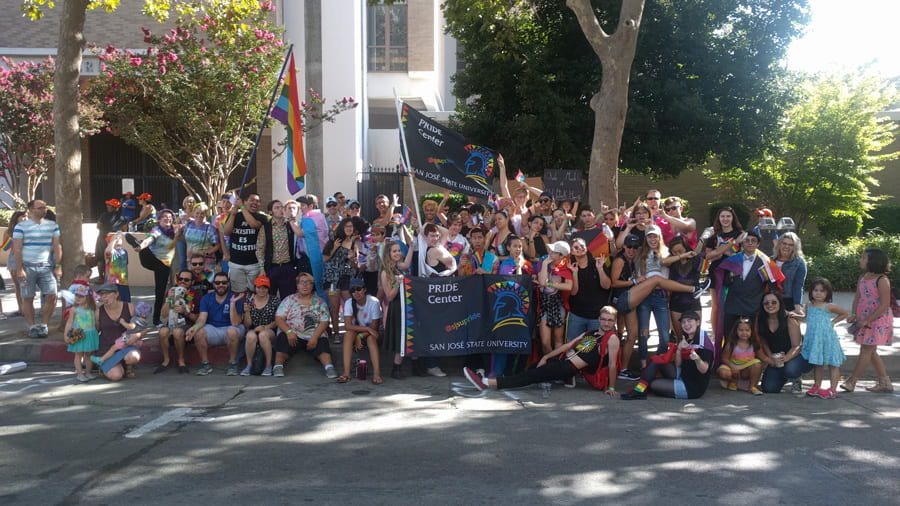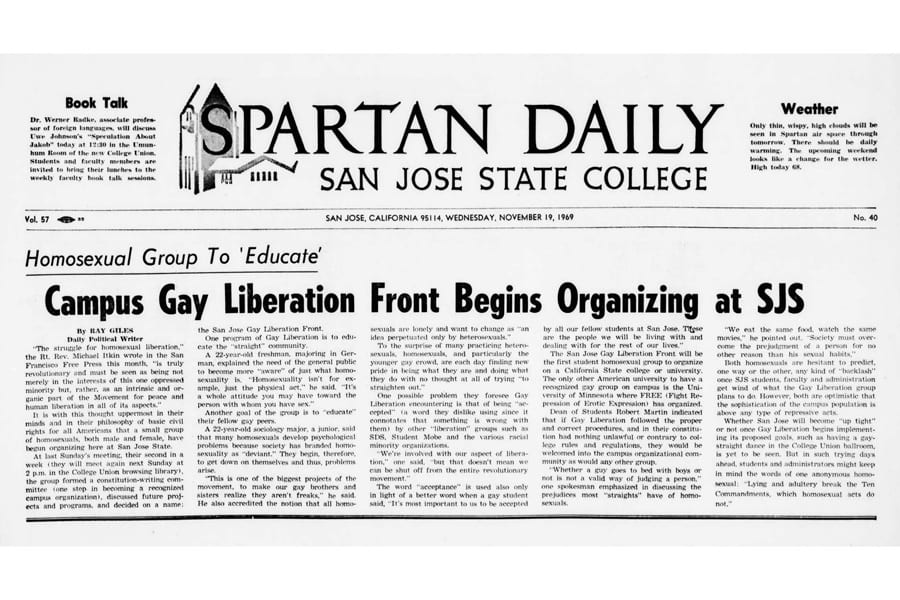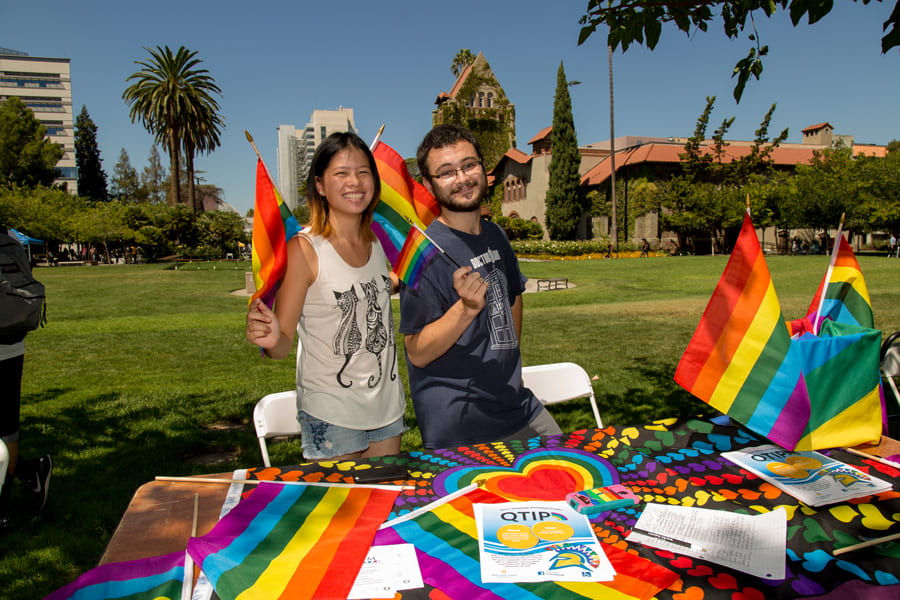Looking Back on the Foundation of SJSU’s PRIDE Center

Community members at a Silicon Valley Pride celebration in 2017.
October is LGBT History Month, and with it comes an opportunity to explore the beginnings of the PRIDE Center at San José State University. First called the LGBT Center, the PRIDE Center was founded in 2008, following a long history of activism in support of an inclusive environment for LGBTQ+ students at San José State.
Some of the early advocates for the PRIDE Center were student government leaders and a small group of faculty and staff — chief among them was Wiggsy Sivertsen, ’62 SJSU alumna, emeritus professor and former director of counseling services at San José State; Debra Griffith, then director of SJSU’s student conduct and ethical development; and Cathy Busalacchi, ’76 Recreation, who was the executive director of Student Union, Inc. and associate vice president for campus life.
Current and founding Director of the PRIDE Center Bonnie Sugiyama (they/them) notes that a study conducted by psychologist Angela Krumm, who was then a part of San José State’s Counseling Services, also played a role in demonstrating how a center of this kind could benefit the community. Wiggsy and Griffith also credit SJSU’s former president Don W. Kassing (2004-2008), for his support of funding to establish the center.
Creating a path to visibility

The Spartan Daily Newspaper from November 19, 1969 announces the beginnings of the GLF.
An icon in the LGBTQ+ community at SJSU, in the City of San José and in Santa Clara County, Wiggsy said the early life of the gay community at SJSU was not comfortable. In the ’60s and ’70s, there was a lot of activism in the Bay Area, especially for civil and Black rights, gay rights, women’s rights and anti-war movements; but it was not easy for LGBTQ+ people to speak out.
“To speak out against anti-gay violence, you were assumed to be gay yourself,” she recalled.
And that assumption was negatively charged.
Warren Blumenfeld, who attended SJSU from 1966 through 1970 — now a renowned writer and social justice educator — corroborates the bias and discrimination the LGBTQ+ community faced during that time at California State University (CSU) campuses. He recently shared his experience as an openly gay college student in an anti-LGBTQ+ climate with SJSU Chief Diversity Officer Kathy Wong(Lau).
In the discussion, he described how Glenn Dumke, then chancellor of the CSU system, denied recognizing the Gay Liberation Front’s existence in 1970. Because it was not yet permitted for the GLF to officially hold meetings on campus, they met at a diner on San Fernando Street, a few blocks off campus. According to Wiggsy, the group continued to meet at various places near and around San José State for years without a dedicated space to call home.
In the early 1970s, a number of students and faculty members at Sacramento State University filed a lawsuit to address the legality of a public university’s denial of recognition to LGBTQ+ student groups in California and won, further paving the way for other gay and lesbian student organizations across the country to become visible on their campuses.
Documenting change
At present, there are gaps of historical knowledge of the LGBTQ+ community’s activities at SJSU between the 1970s and 2000s, but SJSU’s PRIDE Faculty and Staff Association is currently working on a timeline for their website to remedy this. There is also an extensive documentation of the rich history of the LGBTQ+ community in the university’s surrounding area, thanks to SJSU lecturer Ken Yeager, ’76 Political Science.
Yeager was the first openly gay elected official in Silicon Valley, first as a trustee of the San Jose-Evergreen Community College District (1992-2000), a member of San José’s City Council (2000-2006) and a Santa Clara County Board of Supervisor (2006-2018).
He pioneered “Coming Out: 50 Years of Queer Resistance to Resilience in Silicon Valley,” an exhibit displayed at History San Jose museum earlier this year that chronicles the story of the LGBTQ+ civil rights movement and traces five decades of Silicon Valley Pride events, the experience of the AIDS epidemic in the South Bay, and how the LGBTQ+ community made progress in the area’s high-tech and other professions. The exhibition first launched virtually as the Queer Silicon Valley website.
“The exhibit tells the history that younger LGBTQ people know little about and have had limited access to,” Yeager wrote in an op-ed in The Mercury News. “The hope is that it allows them to see themselves in the continuum of an older queer generation that forged a path for them to walk.”
There were a lot of dark days for the LGBTQ+, especially in the ’60s, ’70s and ’80s, explained Wiggsy, that people nowadays may not know about. SJSU students in particular, she said, may not have time to be as active in the community as they were then; she thinks it has a lot to do with the family and job commitments many of them have.
When the PRIDE Center was eventually established at San José State in 2008, it was located in the former Building BB, where SJSU’s 10-story Campus Village 2 residence hall is located today. That’s when Sugiyama, champion of social justice issues for more than 20 years — first as a student and then as a professional at several CSU campuses — came on board.
Building from the ground up
Sugiyama simultaneously set up the PRIDE Center and the Gender Equity Center (then the Women’s Center) side-by-side in a five-room space. Serendipitously, a local feminist bookstore (now defunct) called Sisterspirit, founded by SJSU women’s and gender studies graduate program alums, was downsizing inventory and offered to donate books for the centers. They were happy to pay the resources forward.

Students tabling at a student organization fair in 2009. Photo: D. Schmitz
It took a while to establish knowledge of the center around campus — and for the LGBTQ+ community to realize the resource was available to them.
“Where that building used to exist near student housing, nobody really knew about us yet,” said Sugiyama. “The first three years of any sort of new program is hard because folks don’t really know who you are, and you’re still trying to figure out and establish yourself.”
After eight years and a few moves around campus, the PRIDE Center eventually found its home in the Student Union in 2016, where it is today.
A new generation
Today, the center is supported by Counseling and Psychological Services (CAPS) and encourages the well-being of all LGBTQ+ students on campus. It provides a brave space to cultivate community, such as through its Peers in Pride (PIP) mentoring program, while also encouraging a broader climate of inclusion on campus. Read more about this work.
The PRIDE Center also provides space for student-run organizations and student meetups, including Asexual/Aromantic, Bisexual/Pansexual; Out in Science, Technology, Engineering, Arts and Mathematics (oSTEAM); Queer and Asian (Q&A); Queers Thoughtfully Interrupting Prejudice (QTIP); and Trans Talk. The center also hosts student facilitated group meetups for those identities who don’t have a specific organization and social “gayme” nights on Thursdays.
During the pandemic, the center was able to continue much of the social programming online through the platform Discord. They created different channels for all the groups that exist, providing a much-need respite from Zoom that many of the students appreciate.
This fall, the PRIDE Center is also co-sponsoring a conversation with Janet Mock, transgender rights activist and writer, director and executive producer for the television show “Pose” on Nov. 9 at 6 p.m. as part of the Spartan Speaker Series.




